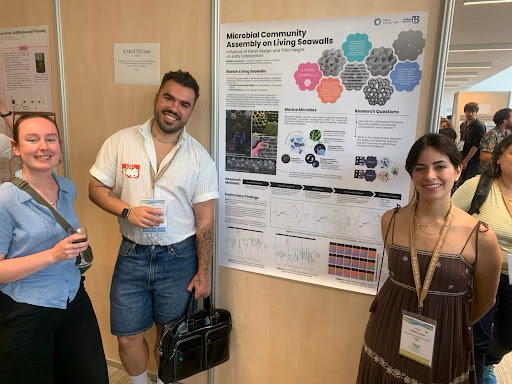From Boston to Brest: Stone Living Lab Presents at the International Temperate Reefs Symposium (ITRS) in Brest, France


by: Jarett Byrnes
Conferences are a mainstay of how scientists keep each other informed of the latest and greatest developments before they splash onto the pages of an academic journal. They’re also fertile grounds for generating ideas, networking, new collaborations, and a great place for students to put themselves on the center of the professional stage. This July, the biological monitoring team from the Stone Living Lab (Jarrett, Curtis, Daniel and Melba) went to the International Temperate Reefs Symposium (ITRS) in Brest, France, and shared the Lab’s work on the emerging ecology of nature-based approaches with an international audience.
ITRS is a unique meeting. It is held every three years and alternates between the Northern and Southern Hemisphere. It’s generally small and focused – although this year had about 400 people – on the ecology of rocky intertidal and subtidal shores in colder water environments. This year 28 countries were represented in the breadth of presentations. In recent years, the Living Seawalls group and other nature-based approaches have become more and more prominent, often hosting full sessions. This year, the meeting opened with keynote speaker Dr. Melanie Bishop of the Living Seawalls group, one of the Stone Living Lab’s close collaborators.
Our team had a strong showing! Daniel Lopez led off with a poster about the Boston Living Seawalls project introducing the project as well as early results showing that rockpools were taking an early lead in colonization success. Melba Torres Sosa showed how panel type did not seem to alter early microbial biofouling communities, meaning that all species had similar biological conditions for early colonization. Last, Curtis Morris showed off his early work and designs to assess if coralline algae – algae that forms hard calcified crusts – might aid in the development of wave-breaking kelp forests.

Daniel Lopez and Curtis Morris with their posters.
The meeting was also a great nexus of meeting collaborators and learning about the latest and greatest in research on nature-based approaches. Aside from Dr. Bishop’s presentation and ensuing conversations with the team, we heard talks on eco-engineering of 100 artificial rockpools on a dyke in Brest from Angelica Enrique, the importance of aesthetics in Living Seawalls acceptance by communities in Plymouth from Jessica Allen, an incredible ¾ of a mile seawall in Singapore with 1500 different panels using novel designs to promote biodiversity by Annie Chew, an incredible talk by Franz Bauer on the carbon stocks held by Living Seawalls in Plymouth, and more. Along the way, keynotes taught us to think from the perspective of animals (Brian Helmuth with a banger of a talk) and about the origins of marine ecology in France through an incredible network of marine labs and biodiversity surveys and experiments by Fischer-Piette and others in a memorable lesson from Steve Hawkins.

Jarrett Byrnes talked with Dr. John Griffin of Swansea, a collaborator on the Plymouth Living Seawall.
The posters provided a riot of even more ideas. Different Living Seawalls projects and other coastal biodiversity engineering projects were out in force. Moreover, several posters went deep into Green Gravel – a potential solution for planting kelp beds. These aligned beautifully with a poster on kelp beds as potential ways to dampen waves, spawning a new collaboration between the Stone Living Lab and Pippa Moore’s group at Newcastle University in the UK. And as always, Stone Living Lab Scientific Advisory Committee Member Louise Firth knocked it out of the park with a Beauty and the Beast themed poster on limpets (we should note, since her visit to the Stone Living Lab Conference, the Biological Monitoring team has seen more limpets in the intertidal than in the past 13 years).
Overall, this was an amazing meeting to share the Stone Living Lab’s work, with new ideas, collaborations, and a lot of cheese and seafood fueling our adventures in France.

Meeting new collaborators goes so much better when you assemble a proper cheese plate.